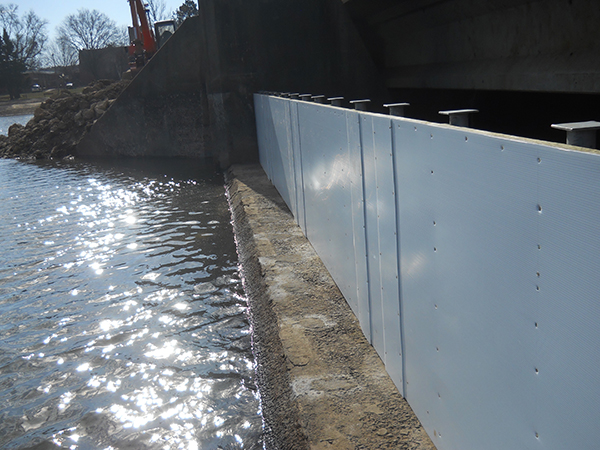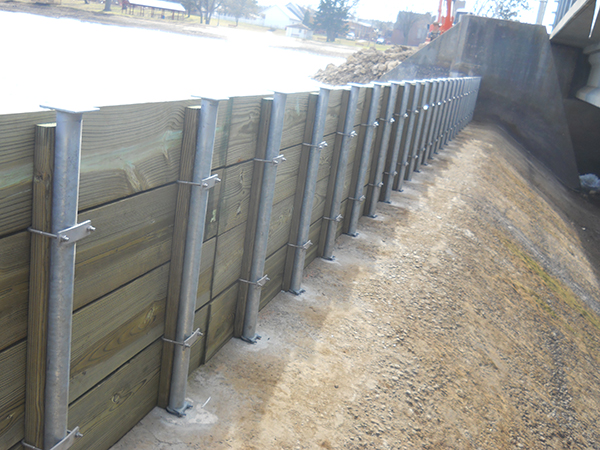Quality Engineering Leaves Area Around Deluged Dam Safe, Not Sorry; Inspection Follows
 There’s nothing like a flash flood to illustrate the value of professionally designed dam components … and the value of timely inspections to make sure floodwaters have not left the dam compromised.
There’s nothing like a flash flood to illustrate the value of professionally designed dam components … and the value of timely inspections to make sure floodwaters have not left the dam compromised.
It didn’t take long for the Village of Strum’s new Crystal Lake Dam flashboards to prove their effectiveness. Wisconsin Department of Natural Resources (WDNR) Watershed Management Engineer Mark Stephenson complimented Ayres Associates on the performance of its flashboard design and praised the Village on its maintenance and operation of the 1930s dam after last week’s flooding triggered about half the flashboards – installed in late 2012 – to activate, allowing the spillway to pass the Buffalo River floodwaters over the dam on September 6.
The metal pipes behind the dam’s flashboards were designed to bend under the pressure of a high-water event such as the Labor Day weekend flash flooding in west-central Wisconsin, and that’s exactly what happened. The fact that the flashboards gave way incrementally meant there was not one sudden wall of water heading downstream all at once. That helped to minimize damage to downstream properties along the Buffalo River. The flashboard pipes can be seen in one of the accompanying photos taken during construction; during normal conditions, water flows over the flashboards from left to right.
 In 2009, Ayres completed the feasibility study that evaluated several alternatives to replace the Strum dam’s outdated flashboard system, including crest gates, split leaf gates, and tainter gates. Ayres then worked with the WDNR to develop a new flashboard system the WDNR would accept and that met the Village’s budget.
In 2009, Ayres completed the feasibility study that evaluated several alternatives to replace the Strum dam’s outdated flashboard system, including crest gates, split leaf gates, and tainter gates. Ayres then worked with the WDNR to develop a new flashboard system the WDNR would accept and that met the Village’s budget.
Pete Haug, an Ayres water resources engineer, designed a system with vertical support pipes designed to fold down under the pressure of a high water event. Regulators and dam operators often prefer more expensive, more permanent gate systems for dams that allow better control of flood flows and can restore lake elevations to normal pool quickly after a flood. But a gate system can cost up to 10 times what a flashboard system costs. The Village agreed to incorporate an operation plan and to maintain a supply of flashboard replacement parts with the same engineered properties as the originals. The WDNR accepted this design, which minimized the chance that inferior replacement parts would be used in future post-flood repairs, and the Village appreciated accomplishing an effective system at a fraction of the cost of a gate system. Ayres also assisted the Village in applying for a WDNR Municipal Dam Grant to fund 50% of the project.
Within a week or two, the water behind the Strum dam was expected to recede to the point where the Village can install replacement flashboard pipes and salvage and/or replace the boards to restore normal lake levels.
In the meantime, Ayres emphasizes that post-flood is an important time to inspect any dam that Mother Nature has put to the test. Issues are easy to identify right after floodwaters recede and before any scars begin to get obscured.
Ayres inspected the Strum dam September 9 and discovered some scour in the riprap system upstream of the dam; after the water recedes, he will inspect the downstream portion of the dam.
Ayres inspected three other west-central Wisconsin dams in the week after the flash flooding. In the case of a Town of Mentor dam near Humbird, Ayres was able to save the client some money by getting clearance from the WDNR to conduct the post-flood inspection as an Owner Responsible Inspection Program (ORIP) inspection. The dam was due for its ORIP in 2016, but last week’s inspection will count as the ORIP inspection. A post-flood inspection basically covers the same ground as an ORIP inspection, but an ORIP inspection is required to be conducted with more stringent documentation.

Post a comment: